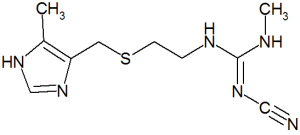WHY DID THIS MAN
DEVELOP NU990PAUSAL SYMPTOM?
A 31-YEAR-OLD MAN with end-stage renal disease started taking 400 mg of cimetidine (Tagamet) daily without his physician's knowledge. Some days, he took a second 400-mg dose of cimetidine. The man had been on hemodialysis for 9 years and also took calcium carbonate.
About a month after starting the cimetidine, he noticed episodes of fluttering, racing heartbeats followed by hot flashes, increased nervousness, sweating, agitation, and shortness of breath. These episodes happened during warm weather and usually lasted 5 to 10 minutes each, although some episodes lasted hours. The frequency ranged from 2 to 20 times per day, When he stopped taking cimetidine, the episodes stopped.
What went wrong?
A similar case of symptoms in a perimenopausal woman on cimetidine has been reported. This is the first report of such a problem in a male patient and in a patient on renal dialysis.
Antacids such as calcium carbonate can interfere with cimetidine absorption, so the two drugs should be taken at least an hour apart. Hemodialysis can reduce blood levels of cimetidine, so it should be taken after dialysis. It's not clear when the patient in this report was taking the drug in relation to his dialysis treatments and his other medications.
In patients with renal dysfunction, cimetidine's half-life is increased from the normal 2 hours. Also, the drug is distributed to many body tissues, where it may accumulate in patients with impaired renal function.
What precautions can you take?
Tell patients to inform their health care providers of all over-the-counter medications they're taking.
Patients on dialysis should take a lower dosage of cimetidine-300 mg P.O. or IN. every 8 to 12 hours, after dialysis. Patients with renal failure also should take a lower dose to prevent the drug from accumulating and to maintain steady blood levels of the drug.
The dose may need to be reduced further if the patient also has hepatic failure.
Sources: "Cimetidine-induced Climacteric Symptoms in a Young Man Maintained on Chronic Hemodialysis." Nephrology, 18:538-540, B. Bastani, et aL, 1998. Nursing2000 Drug Handbook, Springhouse Corp., 2000. Nurse Practitioner's Drug Handbook, 2nd edition. Springhouse Corp., 1998.
Dr. Shuster is clinical associate professor, Temple University, and clinical pharmacist, Medical College of Pennsylvania Hospital, both in Philadelphia, Pa. Send examples of adverse drug reactions to: Joel Shuster, PharmD, The Institute for Safe Medication Practices, 300 W. Street Rd., Warminster, PA 18974. Fax: 215-956-9266. If we publish your item (anonymously), we'll pay you $25.
Copyright Springhouse Corporation Feb 2000
Provided by ProQuest Information and Learning Company. All rights Reserved



